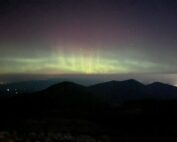Big Bubble, No Trouble
2018-05-15 00:08:14.000 – Caleb Meute, Weather Observer / Meteorologist
Pleasant weather has plagued the summit this week with visibilities stretching beyond 100 miles, too much sunlight, not enough wind, and far too few trips to the precipitation can. While we are on the summit experiencing this awful stretch of perfect weather, a stalled frontal boundary south of the region has provided strong thunderstorms and frequent rain showers that have failed to make their way to us. The good news is that the Auto Road opened up and many visitors were able to make their way here to the summit over the past few days.
The culprit is stubborn high pressure that has kept the frontal boundary suppressed to the south, and coincidentally uneventfully beautiful weather over much of New England. If you like this sort of weather, the phrase “big bubble, no trouble” may be a relatable one as it pertains to a bubble of high pressure that keeps nice weather in the forecast.
But, why?! The simple answer is that high pressure is associated with sinking air, while low pressure is associated with rising air. When air sinks, it becomes drier and warmer whereas rising air cools and moistens. Because the air cools as it rises, it can cause water vapor in the air to condense into liquid water droplets in the form of clouds and precipitation. The reason that high pressure is associated with sinking air while low pressure is associated with rising air has to do with the way that air flows around each pressure center. Another important note is that air flows from high pressure to low pressure. Around a high pressure center, airflow is directed outward and away from the center whereas the airflow with low pressure is directed inward and towards the center. As air flows away from the high pressure center, air must take the place at the surface and as a result the air above sinks (surface divergence). The opposite occurs with low pressure systems where the airflow directed inward is moving towards the center where it collides (convergence) and is forced upward (can’t go into the ground!).

THIS is why the weather has been so beautiful throughout the White Mountains Region for the majority of the shift for us, as high pressure has been in control. I joke about how we do not like the nice weather up here and are always hoping for the worst of the worst. In reality, it is extremely rewarding up here to have stretches like these where we can truly appreciate the amazing views, sunrises and sunsets. It also allows us to go for hikes and really take advantage of living atop New England’s highest peak.

Sunset from May 12th! High clouds shown here are the result of upper level moisture streaming northward from the southern frontal boundary.
Caleb Meute, Weather Observer / Meteorologist
From Weather Observer to Intern, to Observer Again
From Weather Observer to Intern, to Observer Again By Madelynn Smith As I rode in the backseat of our Obs van up the Auto Road for the first time as a full-time employee at
From Mountains to More Mountains
From Mountains to More Mountains: This Time with Stronger Winds By Alyssa Bélanger On the observation deck in high winds. Hello there! My name is Alyssa Bélanger and I am a fall
From Summit to Sign-Off: My Farewell to the Rockpile
From Summit to Sign-Off: My Farewell to the Rockpile By Amy Cotter Enjoying my last Mount Washington sunset (for now) on September 13, 2025. After two incredible years with the Mount Washington




